Hidden in a remote corner of Guatemala's Motagua River Valley is a secret jadeite mine. And, while getting to the site requires many hours of foot travel in rugged terrain, there is a huge reward in reaching the hidden mine: a reef of recently discovered lavender jadeite. The color of jadeite yielded by this particular site in the last eighteen months is so outstanding that the entire history of jadeite in the Americas must now be rewritten. Commercial mining of the lavender jade got underway a little more than a year ago. The material, identified as " translucent jadeite jade" by a GIA trade laboratory report in 1998, has never before been seen in the Americas. The mine owners, Mary Lou and Jay Ridinger, an American couple living in Antigua, Guatemala, carefully stockpiled a cache of the rare color material until they felt the quantity was sufficient to meet expected market demand. In January, 2000, the Ridingers believed conditions were suitable for marketing the jadeite in beads, cabochons, and carvings. It was an instant success, and sales of lavender have topped all expectations.
But that is not the end of the jade story. Other discoveries followed the lavender with finds of jadeite in colors of pink, blue, white and yellow, as well as multicolored boulders. Because of the array of colors in one boulder, the multicolored jadeite promptly acquired the name "Rainbow." Today, all the newly mined jadeite colors, and "Rainbow" are being marketed in jewelry and carvings by the Ridinger's company, Jades, S.A., in Antigua, Guatemala.
 Exploration Adventure in Guatemala Exploration Adventure in Guatemala |
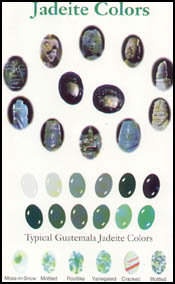
Surface Characteristics and Patterns
The Ridinger's mining adventures actually began long before the lavender jadeite find. In fact, lavender, pink, blue, yellow and "Rainbow" are simply the latest in a series of lucky jade discoveries. In 1974, Mary Lou Ridinger, an archeologist with extensive knowledge in ancient Maya culture and art, combined her passion for the Maya with clever detective skills, logical thought, and study of the writings of mineralogist/geologist explorers in Central America. Leading geologists and archeologists have long concurred in the belief of a main source of jadeite somewhere in Guatemala; some feel there is more than one lode. This primary jadeite source was lost at the time of the Spanish conquest, where the main interest was gold, and forgotten by the native people for more than 400 years. Guided by theory, geology, and results of her past archeological expeditions, Ridinger went looking for the jade source used by the ancient Mayans. Rough jade and artifacts appear to have been actively traded along routes ranging from central Mexico to Costa Rica. Ridinger noted, however, that most geological indicators focused in the Motagua River Valley. Months of exploration eventually resulted in a "Eureka" moment when she discovered a large outcropping of fine jadeite, with original jade working tools scattered on site. Without doubt, Ridinger turned theory into fact and found proof that Guatemala was the source of Jade used in ancient times by the Olmec, Toltec, Zapotec, Aztec, and Maya civilization. In effect, she had made a historic find of the source for most-if not all-the jadeite used by Mesoamerican cultures for three thousand years.
 The First Jadeite Mine for Jades, S.A. The First Jadeite Mine for Jades, S.A. |
The isolated jadeite discovery site covered more than 4,000 acres and became the first mine quarry for the Ridingers. They have since found jadeite in a number of locations in the Motagua River Valley, as well as recovering small boulders from stream beds.
For several years, the first quarry produced jadeite in various shades of green, black, and fine white. A second quarry, discovered in 1987, made jadeite history with its yield of rich black jade containing flecks of precious heavy metals. The jade named "Galactic Gold," is the only jadeite ever seen that contains natural inclusions of silver, nickel, cadmium, pyrite, platinum and gold (verified by laboratory analysis). It looks like a starry night sky, and is visually distinct from any other jade, Jewelers who have never before seen or heard of black jadeite with natural heavy metal inclusions, often refuse to believe it exists, even when they are holding it in their hands.
 Another Awesome Discovery-Blue Jadeite Another Awesome Discovery-Blue Jadeite |
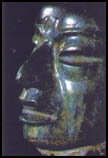
The ancient legend that jadeite brings good luck to its owner must be true, because there was also the astonishing discovery of blue jadeite in the second quarry. The material is a semi translucent, blue-green variety of what has been called Olmec blue. This particular color of blue jadeite is apparently the same material used several thousands years ago by the early Olmecs. The jade is known from its use in ancient Celt (hand axe) and axe-god carvings, with surviving examples usually seen in museums. Olmec blue jade is rare, and until the Ridingers discovered the source in 1987, this prized material has seldom been seen.
 Current Mining Status Current Mining Status |
Currently, Jades, S.A., is operating three quarries while continuing to excavate the same jade outcroppings used by the ancient Maya people of Mesoamerica. For the most part, commercial mining is carried out with fundamental mining techniques. Larger jadeite boulders are broken up using a gasoline-powered jackhammer. Stones are then split into more manageable sizes using a ruby-tipped steel drill to make 8 inch channels in which a spreader-and-rod is forced until the piece cracks apart. The jade is hauled from the roadless valley site by mule train to distant waiting trucks where it is transported to the factory in Antigua. Once the jade reaches the factory it is cut with diamonds saws, fashioned into cabochons, beads, plaques, or carving, and polished by native Guatemalan workers. Following the jewelry making traditions of their ancestors, ten to fifteen thousand traditional Maya designs are produced in a variety of necklaces, beads, earrings, rings and bracelets. There is also a line of contemporary and more modern designed jewelry. Craftsmen produce settings in silver and gold from 14kt to 22kt.
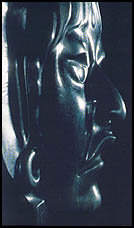
Occasionally jade carvings transcend a single time or culture. this portrait pectoral, from the Olmec Preclassic period (1000-600 B.C.), was later honored by the Maya and most likely worn by a Mayan ruler.
The British Museum, London
Jewelry and carvings are showcased in the Jades, S.A. central showroom in Antigua, as well as their eight other showrooms in Guatemala, Mexico, Honduras, El Salvador, and Costa Rica. Jades, S.A. is the largest jade factory in Central America with roughly 63,000 square feet of factory and showroom area, and more than 100 employees at the Antigua site alone. The jade factory is well-known among tourists celebrities, and politicians. In March, 1999, President Clinton spent two hours at the Antigua factory, picking out gifts of jade for family and staff, posing for pictures, and drinking Antigua coffee. Shortly after the Clinton visit, the Premier of the Republic of China, Vincent Siew, paid a call to jades, S.A., and the first question he asked was" "Is this the same factory where Clinton shopped?" When assured that it was, he smiled broadly and commenced shopping. Other world political figures and celebrities have also come to visit and shop at Jades, S.A.
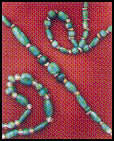
An american couple, Mary Lou and Jay Ridinger, explore Guatemala's Motagua Valley and create new designs from the historic material they mine there. Most authorities believe they have located the source of Mesoamerica's jadeite, lost to the world for centuries. While searching for bright green material, the Ridingers discovered a previously unknown rich opaque-black "Galactic Gold" jadeite, naturally embedded with various heavy metals
 Burial Masks Burial Masks |
A specialty of Jades, S.A., is jadeite mask carvings. Museums and Archaeology departments in North and Central America have commissioned Jades, S.A. to produce replicas of pre-Columbian pieces, such as masks, figures, stela, and ceremonial articles. The most famous replica made by Jades, S.A. is a burial mask of a Mayan noble discovered in 1963, called the Tikal Mask. The original mask, found in 174 pieces at the archaeological site of Tikal in Peten, Guatemala, has been attributed to the early classic Maya culture, circa 527 AD.
 Guatemala vs. Burnese Jadeite Guatemala vs. Burnese Jadeite |
Appreciating Guatemalan jadeite may require a new mind-set for most jewelers and gemologists, or at the least, the perception of ideal "beauty" may need to change, develop, and expand. A course in jade appreciation may be particularly useful for those familiar with only the Burmese material. There are visual differences in the jadeites of Burma and Guatemala, and most of them have to do with color. While some individual pieces of Guatemalan jadeite cannot be distinguished from their Burmese counterparts, the majority of materials exhibit distinct color and sometimes textural differences. For example, the intense and highly saturated green hues of Burma jadeite are not often found in the Guatemalan material. The glass-like transparency and rich "emerald" green color of the classic Burmese Imperial Green, while elusive in Guatemala jadeite, do exist. Some recently mined boulders show small patches of Imperial Green. The most frequent Guatemalan answer to Burmese "Imperial" is a bright green translucent to semi translucent material with fine to medium texture referred to as "Maya Imperial" by Jades, S.A.
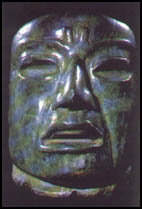
Early Olmec jade mastery, as exhinited in two mask views, set a standard of excellence never exceeded in Middle America
Museum of Mankind, London
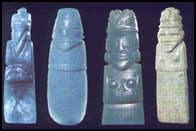
Ax-gods from Museum of Jade, San Jose, Costa Rica
It represents the best quality material found to date in Guatemala "Maya Imperial" by Jades, S.A. It represents the best quality material found to date in Guatemala. "Maya Imperial" is most often found as bright veins in a whitish background, or sometimes as small green spots. More readily available is jadeite in a wide spectrum of greens-mottled or variegated-from, a pale, almost white, mint-green, semi translucent to opaque with coarse texture, to a bright apple green, to green so color-saturated it appears black. When comparing textural differences between Burmese and Guatemalan jadeite, it should be noted that a high percentage of Guatemalan material has a coarse granular crystalline structure whereas the Burmese material generally exhibits a finer texture.
 Guatemala Jadeite Sets Own Beauty Standards Guatemala Jadeite Sets Own Beauty Standards |
Guatemala jadeite is setting its own standards for beauty. The colors are subtle. Guatemala jadeite colors remind us of the muted color palette used by the great French Impressionists Monet and Manet where tones convey a soft, dreamy, romantic quality. The lavender jadeite should more suitably be color-categorized as lilac; yellows are creamy-yellows; pinks are pastel. The intense (naturally colored), highly saturated purple, golden, yellow, reddish-orange, and red colors found in some Burmese jadeite have not been seen in the Guatemalan material.
There are many shades of green in Guatemala jadeite and the following are terms used by Jades, S.A.: mint, apple, mottled, bright apple, and Maya Imperial. There is also lilac, blue , pink, yellow, Galactic Gold, Maya black, white translucent, pure white, gray, coffee, and charcoal. As with most of the jadeite on the world market, price depends principally upon the color. The other elements of value are: Translucency, texture, size, shape, polish, and finish. Jades, S.A. is currently producing a photo color-chart of actual jadeite cabochons to assist in communicating color when ordering or appraising.
 The Importance of Guatemala Jadeite The Importance of Guatemala Jadeite |
A significant factor with the Guatemala jadeite that it has not been subjected to chemical or heat treatment to change the colors.- In today's marketplace where the majority of colored gemstones are baked, heated, or treated by methods both conventional and experimental to intensify color. Untreated stones of natural color are more frequently being requested by savvy buyers. The jadeite market in particular has been besieged with treatments that include bleaching, impregnation with polymers, dyes, and unknown fillings.
"B" jadeite is the name given Chinese jadeite treated with hydrochloric, nitric, or sulfuric acid, then impregnated with resin or wax. The acid treatment removes iron stains and other unattractive colors, but dissolves sodium from the sodium aluminum silicate structure resulting in durability problems. Some "B" jades suffer such severe structure damage they have been known to crumble under the pressure of stone setting. Observations of "B" jadeite show that treated materials often weaken and discolor with time. For gemstone lovers who want to buy jade, but do not want it enhanced in any manner, the Guatemala material provides an answer and alternative. Jades, S.A. guarantees all its jadeite colors as 100% natural.
 Can Guatemala Jadeite be Identified by Appraisers? Can Guatemala Jadeite be Identified by Appraisers? |
During a recent telephone conversation with an appraiser in England, a question was raised about a jadeite bangle being valued: Was it possible the jadeite might be of Guatemalan origin? The bangle, purchased some years ago by a tourist on a Caribbean cruise, was semitranslucent to opaque with a variegated green-and-white color. The appraiser noted that the color tone was soft and muted. From the color description only, the bangle sounded as if it could be Guatemalan material.
When asked for additional information, the appraised gave these specifics: "it is a one-piece bangle with a carved dragon head," he said, adding, "according to a former appraisal it was purchased about ten years ago."
Based on that piece of information the bangle is probably not Guatemalan jadeite. According to Mary Lou Ridinger, jadeite bangles were first produced commercially in Guatemala around 1995, and no known Guatemalan jadeite-in any type of jewelry-has been carved in a dragon's head design. Therefore, for the time being, it is possible that Guatemala jadeite jewelry might be identified stylistically. However, here is the caveat: Stylistic dating of jadeite jewelry may soon become impossible. In 1999, Jades, S.A. offered their first carved Buddha figures for sale. If sales are strong and there is buyer demand for oriental motifs, Asian designs are certain to become a regularly produced item.
Anna Miller, developer of the University accredited Master Valuer Program, has arranged to hold a workshop on location in the Jade mines of Guatemala. The aim of the program is to provide appraisers, gemologists and interested jewelers, the opportunity to study Guatemalan jadeite, learning the keys to properly evaluating and then valuing this historically important material. This hands-on workshop is scheduled for Monday, May 7 to Friday, May 11, 2001. This educational experience is essential for anyone interested in appraising the jadeite prized by Mayan kings. For additional information, subscribers should contact Anna Miller directly at:
Master Valuer P.O. Box 1844 Pearland, TX 77588
Tel/fax (281) 485-1606
Email: mastervaluer@netscape.net
 Value Methods Value Methods |
Appraisers normally use one of two standard methods
to estimate value on gemstones and jewelry: Cost
and Market Data. Cost method means figuring the
replacements cost of each component in a piece of
jewelry (gems ,metals, manufacturing, labor, etc.)
adding it up to get estimated wholesale, and then
adding on an appropriate regional markup to estimate
retail replacement value. Market Data method means
using recent sales of comparable or identical items
to estimate value. The great danger in using Market
Data to estimate value in Guatemala jadeite is in
the tendency of the value to use Burmese jadeite
as a comparable. For accuracy in valuation, Guatemala
jadeite can only be compared with sales of other
Guatemala jadeite. In addition, to be precise, appraisers
should be familiar with the various qualities of
Guatemala jadeite from poor to best, an often impossible
task unless they have actually studied and handled
the material. For this reason also, the Cost method
does not work well for valuation because appraisers
simply pick a price from a general price list without
knowing quality details. |
 Putting a Value on Guatemala Jadeite Putting a Value on Guatemala Jadeite |

There is only one correct way to value Guatemalan jadeite" Be familiar with the material and prices from the source. While gemologists need a sound knowledge of the material's gemological properties and colors for identification, the additional rule for appraisers is: Go to the source of the product to obtain accurate pricing information. Appraising Guatemalan jadeite is akin to appraising designer jewelry or luxury synthetic gemstones; ask the people mining or creating the gems about its precise value. Currently, less than a dozen appraisers in the United States have expertise in valuing Guatemala jadeite. However, they expect the number to increase as Jades, S.A., team up with The Master Valuer Program, an appraiser training program, to give practical on site jadeite education classes in Antigua. (Information about registration for the program may be found in a sidebar accompanying this article.)
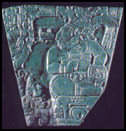
Bas-relief Maya jade plaque dated 600-800 A.D. uncovered at Teotihuacan, depicts an enthroned, regally dressed king accompanied by a court dwarf.
The British Museum, London
They have not yet written the last chapter in the saga of Guatemala jadeite discovery. Expect to hear more about this very special jadeite during the next decade and beyond. They expect other colors, particularly reds, to be found, and the quest for the source of the long sought and treasured Imperial Green is to be continued. Although many diggers believe Guatemala has no more jadeite secrets, the hunters of new sources of precious jadeite will persevere. As Gerald Godfrey of Charlotte Equestrian & Gerald Godfrey Ltd., in Hong Kong, so succinctly stated in a magazine article on jade. "you do not collect - it becomes an addition."
For more information on Guatemala jadeite: Jades, S.A. Fax 502-832-2755 E-mail: jades@mailzone.com. Mailing addresses: Jades, S.A., 4a. Calle Oriente No. 34, Antigua Guatemala.
Note: All photographs courtesy of Anna Miller
 THE OLMEC, MAYA, & AZTECS IN MESOAMERICA THE OLMEC, MAYA, & AZTECS IN MESOAMERICA |
Hernán Cortés led a ragtag band of Spanish soldiers from Cuba to Mexico in 1519. First the red-haired conquistador burned his ships to insure his unreliable "army" couldn't desert. Next he headed inland, toward the Aztec capital of Tenochtitlan-now Mexico City-aiming to conquer Emperor Moctezuma and his empire. Audaciously, with more gall than sense, a few hundred Spaniards confronted the city of 300,000 whose myths predicted the arrival of a red-haired god from agar. So they greeted Cortés with some warmth. Feigning friendship, Cortés captured Moctezuma, thus beginning Spanish denomination that enslaved the people, plundered the land, and almost eradicated the indigenous culture. When the Aztecs grew alarmed at Spanish greed and passion for gold and silver, Moctezuma is said to have observed to his court, "Thank heaven they do not know about the chalchibuites (jades)."
Therein lies another tale of cultural clash. Nephrite that the Chinese loved beyond measure, most Europeans and Americans cast aside as only souvenir-carving material. Jadeite that the Aztecs, and the Aztecs, and the Maya before them, and the Olmec before them, honored as the most precious objects on earth, the Spanish conquistadors dismissed as green rocks.
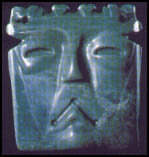
Unique flat tablet Olmec portrait, found on Costa Rica's Atlantic coast appears to be topped with a crown.
Museum of Jade, San Jose, Costa Rica
Seeking a conciliatory gesture to avert pending conflict, Moctezuma told Cortés he wanted to give him some very valuable stones as a present for his king. Moctezuma supposedly said, "These are chalchihuites, not to be given to anyone but your king. Each is worth two loads of gold." Cortés was not impressed, but he did at least send them toward Spain. Unfortunately the jades never arrived. French pirates hijacked the three treasure ships carrying them and precious metals. But the Aztec sense of value survives. Moctezuma had sent a message much like Confucius: gold has a value; jade is priceless.
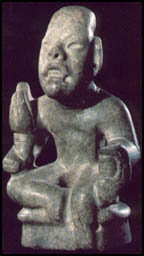
Strong figure with traditional features dates from the Olmec Preclassic period, 1000-600 B.C.
Cleveland Museum Art, Cleveland
After Cortés placed Moctezuma under elegant but strict house arrest, the two continued daily discussions, even playing a native chess-like game, ending it with a gift exchange. One day the Aztec king presented Cortés with large gold and silver disks, which obviously pleased the Spaniard. Noting this, in a desperate attempt to curry favor with the unenlightened infidels, Moctezuma promised that on the following day he would give the most precious gift of all. He offered Cortés three perfect jadeite beads, but, coveting gold, not beads, the conquistador was "bitterly disappointed."
Three grand conjectures attempt to explain how Mesoamericans came to work jade. I consider one to be outlandish, one farfetched, and one tantalizing. Most detached from the truth are writers who propose that the long, straight "runways" on Peru's high plains are alien landing strips and that jade knowledge came from space. In his popular book Kon-kiki, Thor Heyerdahl postulates that boat people from Polynesia settled South America. If so, the theory goes, they could have brought jade skills gained from other islands. Even had the South American immigrants been Polynesians-which they were not-there is no evidence to show Polynesians who might have settled came from islands with jade skills.
Mesoamerica's and China's historic and cultural relationships with jade did coincide, resulting in tantalizing parallels too great to ignore. Were they coincidental? Or, did a relationship exist? Some scholars wonder if the famous "land bridge" that twice allowed people to migrate by food from Siberia to Alaska (then to disperse throughout the Americas) also transported Chinese stone craft and devotion to jade. The 25,000 B.C. and 12,000 B.C. migration periods occurred long before any known Chinese association with jade. That said, I find striking similarities between Chinese jade history and what transpired in Mesoamerica.
Begin by comparing Chinese figures with the Costa Rican ax gods on pages 12-13. Also consider that the Maya (and sometimes the Aztecs) assembled burial jades even more elaborate than China's. Mesoamericans entombed royal personages wearing jade suits and masks, lying inside giant stone sarcophagi covered with jade. They arrayed their deceased in jade head bands, jade tubes to hold their hair in place, jade wrist cuffs, jade necklaces, ten jade rings, and surrounded them with personal jade objects. And ponder these other coincidences between China and Mesoamerica. The Aztecs named their brilliant green jadeite quetzalitztli, after their vibrantly-hued bird, the quetzal; in China the best green Burmese jadeite became fei-is'ui, after the kingfisher's colorful feathers. Both the Maya and the Chinese shared beliefs of jade's extraordinary powers to heal the sick or injured, exorcise demons, prevent or delay body composition, and even bestow immortality.
The natives who had already populated the areas of and between what are no Mexico and Peru discovered jadeite. On their own they mastered carving without the benefit of metals. The Olmec, who created the first culture in the Western Hemisphere, flourished on Mexico's Gulf Coast between 1300 B.C. and 400 A.D. Jade masters for more that a thousand years-during the same period hen China's Shang and Zhou Dynasties produced elegant nephrite pi,kuei, and ts'ung symbols-the Olmec carved human faces ever carved in jade. Although less well know, the Olmec brought jade carving to a level that allowed the Maya and Aztecs to build on a solid artistic and technical base.
After the rapacious Spanish assault on native culture and religion, Indians withdrew so far from their roots that subsequent generations not only did not know how to carve jade but had no idea where to find it. Because Mesoamerican jade carvings older that the Olmec do not exist, we assume the Olmec first discovered New World jadeite. The mine or mines were lost to the world from the 1500s until the 1960s.
Scientific sleuthing began after World War II with William Foshag, Smithsonian's curator of geology. Followed by archeologists in the 1960s. (as well as a single lucky find by an American businessman in 1957), the search for the source of Mesoamerican jadeite not only centered in Guatemala but on a single location, the remote Motagua Valley.
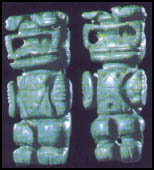
Figures that support alien visitor theories
The dogged determination of an American couple, Mary Lou and Jay Ridinger, led them to discover in jadeite boulders. More exploration in the valley produced jadeite in a variety of colors. More exciting, they identified old Mayan work sited where small outdoor carving factories had operated in fixed locations for centuries. Today's miners still find small pieces of worked and untouched jadeite, as well as tools and pottery.
Resolving another mystery, the source of foamy blue-green jadeite favored by Olmec carvers and often found in Costa Rican graves, a decade ago the Ridingers discovered the first such in situ boulder, thus proving that both the Olmec and Maya mined jade in the Motagua Valley. Their next quest was to locate the source of brilliant green jadeite that researchers had found in tombs all over Central America, particularly in El Salvador and Belize. No such color had appeared after years of mining in the Motagua Valley. The absence of emerald-green or imperial-green jadeite led to speculation that the Olmec had exhausted the original source or that another yet undiscovered mine held the secret. Then in the 1980s. the Ridingers found a few boulders with small bright green spots-but without imperial jadeite's translucency-leading them to believe that the most desirable of all Mesoamerican jadeite colors originated in Guatemala's Motagua Valley, although never in large quantities.
Finally, we understand why the Olmec and Maya produced so many beautiful jadeite carvings whereas the Aztecs, even though they revered jade as much, made relatively few. Records indicate that the first two cultures had direct access to Guatemala's mining area; the Aztecs apparently had to rely on southern tribes, who paid tribute in jade, but kept their source secret. Based on jadeite colors and textures, we now believe that Guatemala's Motagua Valley supplied all or most of the jade used throughout Mesoamerica for about 3,000 years. To date no one has found another mine.
No one knows with certainty whether the Olmec and Mayan cultures blended into one around 300-400 A.D. or if the Maya developed separately farther north in Mexico. Either way, between 300-600 A.D. the Maya dominated Mesoamerica with one of the world's most advanced cultures. Their abstract reasoning, mathematical skills, 365-day calendar, sculptures, hieroglyphic writing, and architecture had no equal in feudal Europe. By the Late Classic Period, 600-900 A.D., an estimated fourteen million Maya lived in what are often described as the world's most modern urban centers of the time. And like the Chinese, although they had crystal gemstones, gold, and silver, the Maya made jade the focal point of their rituals, elevating it to the most important and precious material in their society. They also had what are for us some unpleasant ceremonial customs.
Jade knives and bowls played central ritual roles in human sacrifices and bloodletting, which the Maya commonly practiced in multiples at important events. Contrary to their unwarranted reputation as placid natives, the Maya sought conflict as a means to capture prisoners. And in the civilization that followed, the ferocious and brutal Aztecs expanded sacrificial offerings to such an extent that they had difficulty maintaining an inventory of victims to keep up with ritual demands.
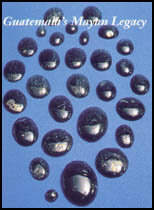
"Galactic Gold" cabochons and artifacts courtesy Jades, S.A., Antigua, Guatemala
In Mesoamerica many substances carry "jade" or "jadeite" labels. The world contains numerous green black stones. With no nephrite in Central America, anything marked jade should be jadeite, and certainly anything marked jadeite ought to be, because it is the proper name for a specific substance. Geologists, gemologists, and appraisers subscribe to this practice. But far too many archaeologists, museum curators, historians, grave robbers, and unscrupulous sellers prefer to lump anything the Olmec, Maya, and Aztecs carved under one convenient term, jade. This creates confusion that needs not be so, if not outright misrepresentation.
Kings were invariably buried with true jadeite, which proves that the original carvers knew the difference between jadeite and other stones, mainly by hardness and appearance. But workers cut the stones they had, and many of today's museum pieces contain mixtures of jadeite, diopside, albite, and numerous other materials. Only when a piece is composed of almost all jadeite, usually ninety percent are more, do gemologists label it jade. Other substances, like serpentine or chloromelanite, should be accurately identified. At least they should not be misidentified as jadeite. Academics recently have taken a strange stand, creating totally new terms like "cultural jade" and "social jade" to describe non-jadeite pre-Columbian carvings. The buying public needs to take notice of this dangerous practice.
As one of the three surviving jade cultures, Mesoamerica owes much of its current success with jadeite to Mary Lou and Jay Ridinger and sales to Guatemala's foreign visitors. Jades, S.A. mines its own jadeite and produces a full line of popular jewelry as well as replicas handmade by Mayan descendants from the jade treasured and recered by priests and rulers. To its credit, in a practice all too rate, Jades, S.A. clearly marks replicas as such.
Foreign domination by the English and Spanish severed native links to an historic jade past in New Zealand and Mesoamerica. In both areas non-native interest was initially responsible for an explosive growth in local carving. Now New Zealand and Canadian non-native carvers are generating renewed global awareness of jade designs as fine art. First-generation Guatemalan carvers are just beginning to realize the impact local jadeite had on their ancestors.
Glamour, intrigue, romance, the quest for treasure.those are all vital aspects of humankind's eternal search for and love of gemstones. As long as people have roamed the world, they have placed extraordinary value on our incredible gifts from the land and sea.
Jades of Mesoamerica is the ninth in a series of gem books written and photographed by Fred Ward. Each book, Opals, Rubies & Sapphires, Emeralds, Diamonds (in English and Russian), Peals, Gem Care, and Jade, is part of a 19-year global search into the history, geology, lore, and sources of these priceless treasures. He personally has visited the sites and artifacts displayed here to provide the most authentic and timely information available in the field. Fred Ward's original articles on these topics first appeared in National Geographic Magazine. In addition to being a journalist, Mr. Ward is a Graduate Gemologist (GIA), the highest academic achievement in the gem trade.
Mr. Ward, a respected authority on gems and gemology, is in great demand as a speaker. This book, printed for Jades, S.A., is part of the continuing computer desktop publishing revolution. It was designed in Mac Page-Maker, separated and color-corrected in Adobe Photoshop, and printed by H & D Graphics in Hialeah, Florida using Adobe Janson typefaces.
|

